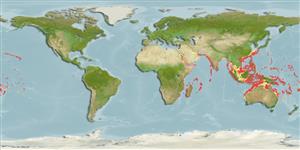Environment: milieu / climate zone / depth range / distribution range
Ekologi
marina revassocierade; ej vandrande; djupintervall 40 - 300 m (Ref. 89972), usually 100 - 250 m (Ref. 9710). Tropical; 30°N - 59°S, 29°E - 150°W (Ref. 5222)
Indo-Pacific: islands of the western Indian Ocean to Japan and the central Pacific. Except for a single specimen caught off the coast of Natal, South Africa, Heemstra and Randall 1993 know of no confirmed records from other continental localities of East Africa. Cephalopholis aurantia from east Africa reported by Morgans 1982 (Ref. 6448) is a misidentification of Cephalopholis nigripinnis.
Size / Vikt / Age
Maturity: Lm ? range ? - ? cm
Max length : 60.0 cm TL hane/ej könsbestämd; (Ref. 4319); common length : 30.0 cm TL hane/ej könsbestämd; (Ref. 5450)
Taggstrålar i ryggfenan (totalt): 9; Mjukstrålar i ryggfenan (totalt): 14-16; Taggstrålar i analfenan 3; Mjukstrålar i analfenan: 8 - 9. Pale orange-red to orange-yellow or golden with red or yellow dots on head, anterodorsally on body, and on base of dorsal fin. Posterior margin of caudal fin with a pale blue edge and black submarginal line; posterior parts of dorsal and anal fins often with a narrow pale blue edge; further characterized by having ctenoid scales on body including most of abdomen; greatest body depth 2.5-3.0 in SL; rounded caudal fin; pelvic fins usually reaching anus, 1.6-2.0 in head length (Ref. 90102); head length 2.4-2.6 times in SL; interorbital area flat; rounded preopercle, finely serrate, lower edge fleshy; subopercle and interopercle serrate; scaly maxilla, reaching to or beyond vertical at rear edge of eye (Ref. 89707).
Rare species (Ref. 4319). Found on steep seaward reefs (Ref. 9710). Museum specimens are lacking. Usually at depths of 100-250 m, but can occur in shallower water (Ref. 89707). Feeds mainly on crabs (Ref. 89972). Solitary (Ref 90102).
Life cycle and mating behavior
Könsmognad | Reproduktion | Lek | Ägg | Fecundity | Larver
Heemstra, P.C. and J.E. Randall, 1993. FAO Species Catalogue. Vol. 16. Groupers of the world (family Serranidae, subfamily Epinephelinae). An annotated and illustrated catalogue of the grouper, rockcod, hind, coral grouper and lyretail species known to date. Rome: FAO. FAO Fish. Synop. 125(16):382 p. (Ref. 5222)
IUCN Red List Status (Ref. 130435)
Threat to humans
Harmless
Human uses
Fiskeri: mindre kommeriell
Ytterligare information
PopulärnamnsynonymerMetabolikPredatorerEkotoxikologiReproduktionKönsmognadLekSpawning aggregationFecundityÄggEgg development
referenserVattenbrukVattenbruksprofilAvelslinjerGenetikElectrophoresesÄrftlighetSjukdomarBehandlingNutrientsMass conversion
MedarbetareBilderStamps, Coins Misc.LjudCiguateraHastighetSimsättGälytaOtolithsHjärnstorlekSyn
Verktyg
Special reports
Download XML
Internet-källor
Estimates based on models
Preferred temperature (Ref.
123201): 13.1 - 25, mean 19.1 °C (based on 438 cells).
Phylogenetic diversity index (Ref.
82804): PD
50 = 0.5000 [Uniqueness, from 0.5 = low to 2.0 = high].
Bayesian length-weight: a=0.01259 (0.00590 - 0.02687), b=3.04 (2.87 - 3.21), in cm total length, based on LWR estimates for this Genus-body shape (Ref.
93245).
Trofisk nivå (Ref.
69278): 4.0 ±0.65 se; based on food items.
Resiliens (Ref.
120179): Mellan, lägsta populationsfördubblingstid 1,4-4,4 år (Preliminary K or Fecundity.).
Fishing Vulnerability (Ref.
59153): Moderate vulnerability (44 of 100).
Nutrients (Ref.
124155): Calcium = 32.8 [17.5, 54.9] mg/100g; Iron = 0.437 [0.239, 0.833] mg/100g; Protein = 18.6 [16.7, 20.2] %; Omega3 = 0.178 [0.109, 0.295] g/100g; Selenium = 57.9 [29.9, 100.8] μg/100g; VitaminA = 82.8 [30.0, 262.9] μg/100g; Zinc = 0.748 [0.512, 1.205] mg/100g (wet weight);
